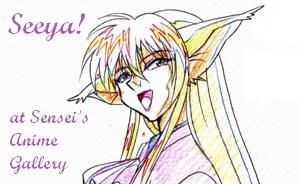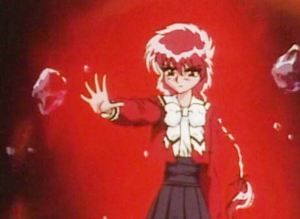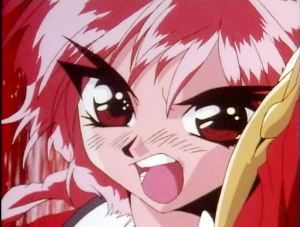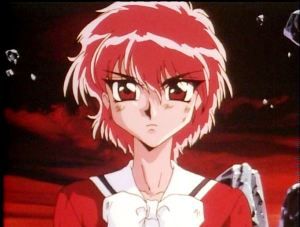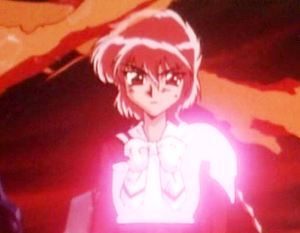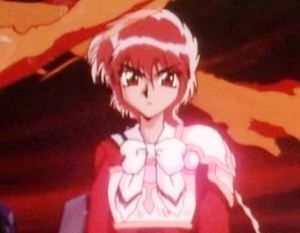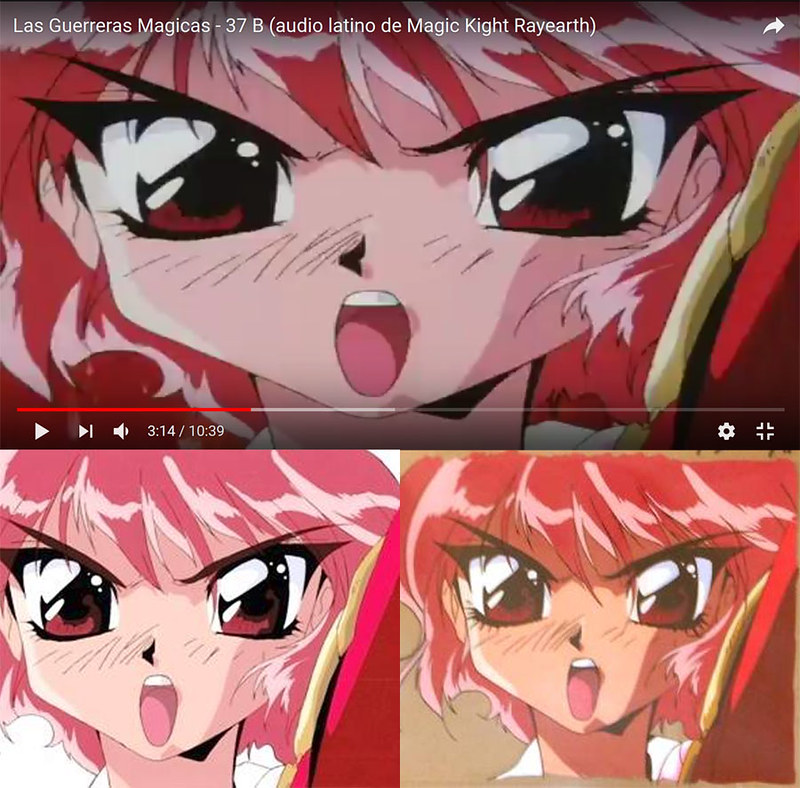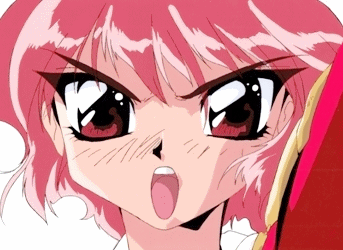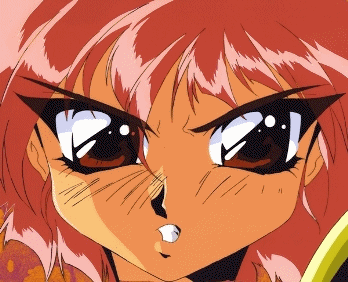It's standard wisdom that when two (apparently) identical cels appear, only one can be an authentic piece of production art, the one that did go under the camera to make the scene in which it appears. The other might be a rejected image, a test cel, or -- increasingly -- a forgery.
One of my prized possessions is a set of roughs and shuuseis that work out one of the most dramatic moments when Hikaru, the central character in Magic Knight Rayearth, casts her most powerful magic attack, "Fire Arrow." (I famously bid on this using both SMJ and Rinkya to kaflummox a determined bunch of Japanside bidders.) Sadly, this set lacked the rough for the A1 start keyframe, but did preserve a post-genga partial shuusei.
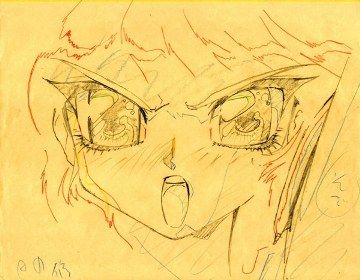
No matter: a few years later I was able to obtain another prize, the matching A1 cel from this sequence:
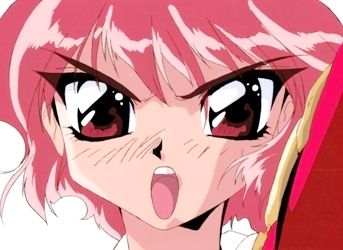
[I apologize for the differing color qualities in a number of these scans. My scanner tends to make Hikaru's hair pinker than it actually is. The two largest scans have been tweaked to make them as close to the color qualities in actual cel as possible.]
But ... recently a YHJ seller advertised what appeared to be the identical A1 cel for sale:
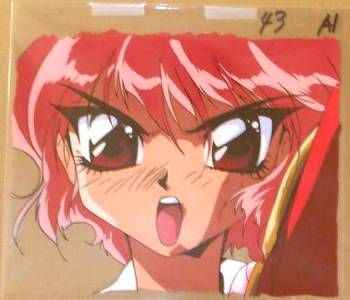
That's got to be a fake, I thought. Look at that bold, too-big sequence number, which was similar to others I either considered or determined to be fakes. And yet ... a number of things about it gave me pause. What if it were the original and the one I'd bought before was the fake? That one compared well to the screen capture I had ... but could I be really sure?
Well, the cel went around several times, and the seller eventually marked it down from its original premium price. When that got to a level I felt I could afford, I plunked down a bid, feeling that the sale price was worth it to resolve the question. And the cel arrived earlier this week.
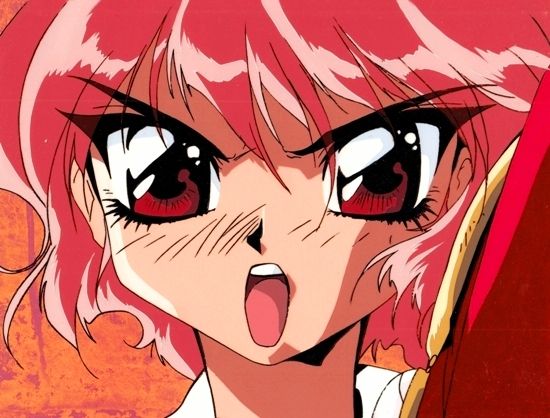
Oh, yeah, was my first thought. Look at those trace lines -- way too sharp for a 20-year-old cel and all those highly reactive reds, pinks, and flesh tones. I looked very closely at them, however, and even though they looked new, they also didn't look cheap like my imfamous Yue/Touya fake. Then I got the cel out of its bag and found a surprise waiting. There were two tape strips at the top of the cel (odd -- why on a single-layer A1 cel?) and I found they held ...
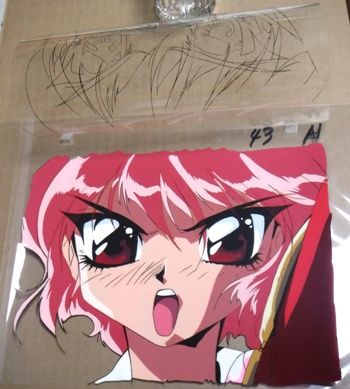
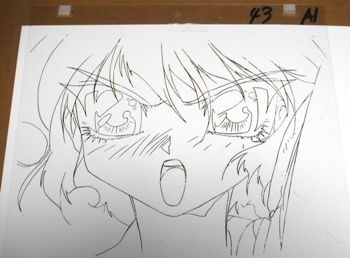
... a clear cover sheet that contained nothing more that a set of trace lines reenforcing the ones on the cel. This was not stuck, and under it was ...
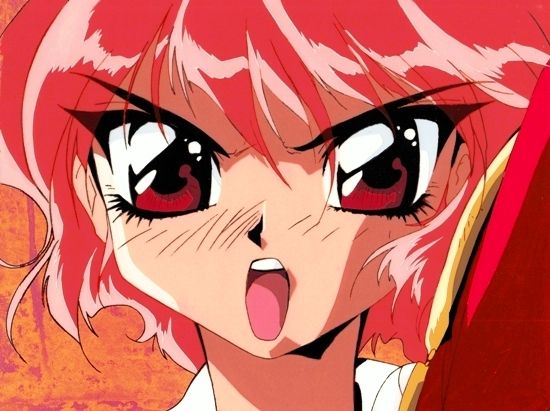
...a nice A1 cel with 20-year-old faded trace lines: good-looking for its age, but about the same level of line fading as the "identical" cel I already owned. If it was a fake, then, it looked to have been done a long time ago. (Or aged by exposure to strong light? If so, why the reinforcing layer?)
OK, now the job was to flicker scans of the cels carefully. As expected, they were very nearly but not quite entirely identical:
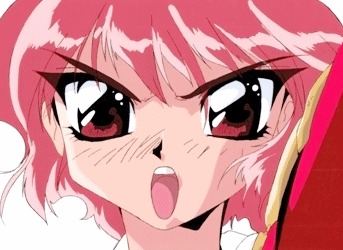
Most obviously, several of the hair strands are longer in the "new" A1 cel, and the shoulder pad on Hikaru's arm is different. I compared the "old" A1 cel to the screen cap and found it was the same in both ways. OK, case closed? Well ...
I'd been concerned for some time that my A1 shuusei sketch was in fact different from my "old" A1 cel in a couple of ways. Flickering these makes this clear:
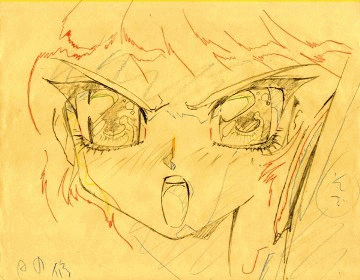
Notice particularly that the bottom eyelashes stick out farther in the sketch than they do in the cel. The “old” A1 cel matches the screen cap but the sketch matches the “new” A1 cel.
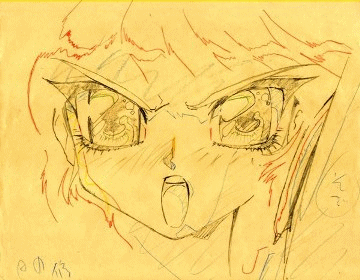
(Less dramatically, I found that the shadow lines in Hikaru's enormous eyes also were the same in the sketch and the "new" A1 and different in the "old" A1.)
A final puzzle concerned the sequence numbers on the top right corner of the cels. As noted before, my "old" A1 wrote these in the typically smallish and self-effacing style of most authentic MKR cels:
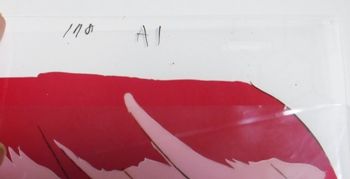
But note the cut number -- "178" -- to the left of the sequence number. That made sense for episode 37 (the source of my screen cap), where this moment fits into the second half of the episode, after the eyecatch (which usually falls around Cut 140-150). By contrast, the cut number for the "new" A1 doesn't fit:
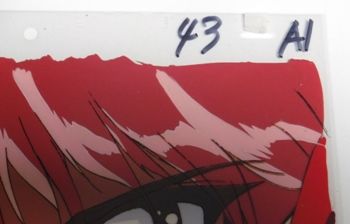
Cut 43 would normally come close to the start of an episode. Might there be two cuts in which this magic attack takes place? In any case, it made me pull out the rest of these "Fire Arrow" sketches, to see if by chance a cut number appeared on one of them. And indeed, at the start of the sequence devoted to how Hikaru's fireball appears, then grows . . .
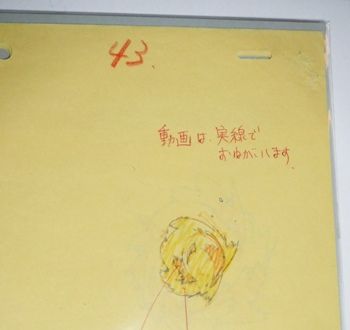
So . . . I'm not sure what to think now. It looks as if my "old" A1 is a genuine enough piece of production art, reliably linked to the scene in Ep. 37. But now it looks as if the sketch and the "new" A1 are also genuine, but linked to a Cut 43 somewhere else. My only hint is that my Ep. 49 cel of Umi/Selece casting Water Dragon also has a larger-than-usual set of sequence numbers, including an indication that it comes from a Cut 42. Coincidence? This cut number likewise makes no sense in Ep. 49, where it takes place in the final conflict after the eyecatch). And yet that "Cut 42" Selece cel flickers perfectly with the screen cap.
One possibility: it's not a cut number at all, but a bank number. The studio might have prepared discrete banks for each of the characters' important magical attacks and other repeated actions such as henshins. Umi's "Water Dragon" might have been #42 of these, and Hikaru's "Fire Arrow" was #43. And these banks would have theoretically been available to use in a Sailor Moon fashion into any scene in which they were used. And so the cels would have a "bank number" that actually had no relevance to the cut count into which they were inserted. The "Water Dragon" attack was perfect for the Ep. 49 scene, so it was used (and presumably elsewhere too). But for some reason the Ep. 37 animation director felt Hikaru's "Fire Arrow" needed a tweak, so a new A1 cel was ordered for this scene.
Or . . . I really don't know what else to think.
In any case, it looks as if I do have two "identical" A1 "Fire Arrow" cels, both of which appear to be authentic.
